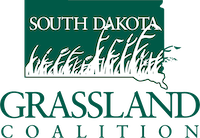By Kate Rasmussen
Dan stepped out of the pickup and waited for the evening songbird chorus to return after being hushed by our arrival. He parked on the top of Cedar Butte— a long, grassy plateau surrounded by badlands—to point out the array of plant species growing at our feet. Cattle haven’t grazed the area during the growing season for over a century. Because of its history, the spot provides a model for the kind of plant diversity Dan shoots for in the rest of the pastures on the 33 Ranch. After a few moments, the air became so thick with songbird calls it was difficult to pick them out individually. I kept my ears peeled for the croaking chirp of a bird called the Loggerhead Shrike—a carnivorous songbird trademarked by its unusual methods of food banking. With a hawkish beak, the Shrike skewers its prey, typically frogs or mice, on sharp objects like barbwire to stockpile for later.
“Prairies and ranchers depend on each other for long term survival. Not enough people realize how important prairies are,” Dan said as we shuffled the grass with our boots to scare off any snakes before taking a seat. According to World Wildlife Fund, the American Great Plains lost more acres to land conversion than the Amazon rainforest in 2014. Dwindling with their habitat, grassland birds have experienced an alarming decline. Songbird populations, and indicator of healthy grassland, have dropped more than 80% since the 1960’s.
Dan operates the cattle ranch his grandfather homesteaded in 1914. He studied economics in college and combined his econ knowledge with a love of grassland ecology. After graduating from SDSU, he picked up a knack for education while teaching agriculture at a rural college in Botswana before coming back to the ranch. The education skills he learned in Africa have come in handy for helping with the Grazing School—a land stewardship education event the Coalition puts on twice a year. The event teaches producers ideas needed to work out the grazing to recovery time ratio their pastures need.
“By allowing the plants enough rest, we encourage the growth of underground energy stores that will be there for us when the markets and the rain aren’t,” he said. The underground energy stores Dan referred to are the perennial root structures probing deep beneath the topsoil. This hidden labyrinth is home to billions of microbes essential to plant health. The microbes break down the organic matter, freeing the minerals and nutrients that sustain the grasslands. “As land managers we share responsibility with everything that happens on the land. If we graze a pasture, it changes the plant community, hopefully, for the better. If we do nothing and choose not to graze a pasture it changes the plant community,” Dan said as we took in the sweeping view of the landscape.
One has to wonder, what does the landscape look like when left completely alone? As if anticipating my in-quiry, Dan led me to a small enclosure nearby. The enclosure was put up in the 50’s to monitor the grazed versus un-grazed plant communities. Inside the enclosure, dried perennials had built up enough of a mat to choke themselves out and give way to invasive annual plants. A few annuals sprouted out of the thick layer of built up organic matter while big blue stem, lead plant, blue grama, and other beneficial perennials flourished just outside the enclosure. “By over or underutilizing prairie we encourage or discourage the competitive ad-vantage of the perennials. When we overgraze perennials and they recede, annual shallow rooted invasive species such as cheat grass and bluegrass have an advantage.”
Dan played a major role in starting the Coalition’s Grazing School and structuring it to help producers gain tools needed to make sound stewardship decisions on the land they manage. “Every choice we make has an impact. The key is learning to make the right decisions over time. Perennial plants are deep rooted and adapted to South Dakota prairie. Perennials are the heart of our prairie.”
Three nighthawks carved loops in the half-light, diving for insect’s suspended over the grass. As we watch the small raptors feed before dark, Dan tells me about a saying his father— a former Coalition board member—often said: “grass is like having a savings account in the bank.” Although we spotted no shrikes, the unconventional songbird has the right idea of storing fuel for later. Encouraging perennial grasses gives producers the opportunity to stockpile energy stores for the future.
Dan often says he doesn’t have grazing on the place all figured out. He does, however, have a reservoir of patience and an eye for the big picture: “Sustainable ranching is truly a rare type of business. Our long-term survival directly corresponds with the quality of wildlife habitat. When we cater to plant diversity, the cattle and wildlife get the best possible nutrition. Where there is healthy grassland, there are fat cattle.”
